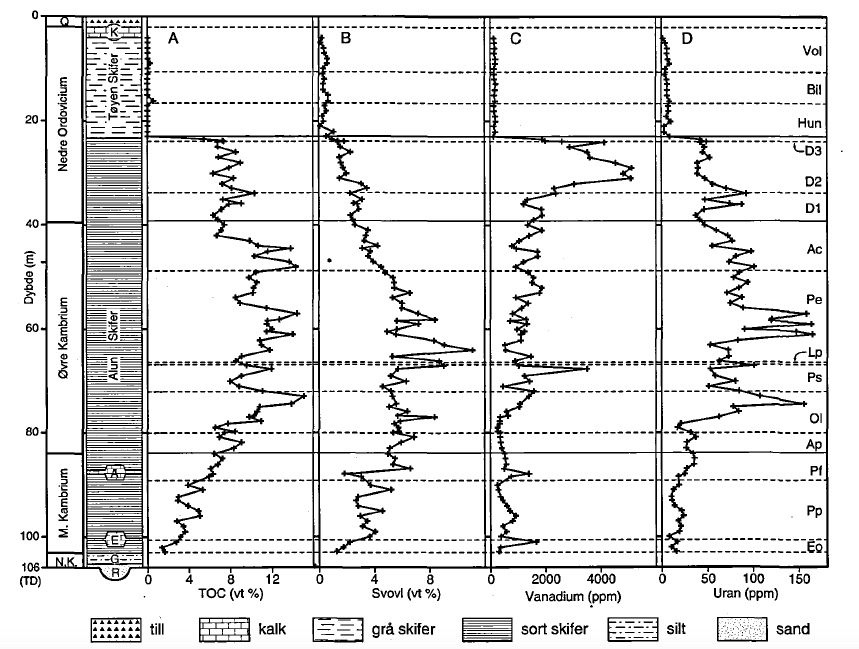A few days ago I looked into Scandivanadium’s most recent work plan for their exploration target Killeröd, where the company is planning to make 8-10 drill holes.
In the work plan the company repeats the same old story; i.e. that the Dictyonema Formation, where high Vanadium contents have been reported, has very low Uranium contents. A look at the figure below tells however a slightly different story. This figure, which is from the publication by Buchardt et al. (1997) depicts the organic carbon content (TOC), the sulphur content (S), and the vanadium (V) and uranium (U) content in the different rock types of the Gislövshammar-2 drill core.
The uppermost part of the black Alum shale corresponds to the Dictyonema Formation (D1 to D3). The Vanadium content is high in level D2, where it reaches above 4000 ppm (or g/tonne). But the Uranium content is also high, around 50 ppm. It is definitely higher than in the overlying Toyen Shale, but lower when compared to the underlying Alum Shale, where the Uranium content is variable and reaches above 150 ppm.
I realize that the figure might be a bit difficult to grasp, but my whole point is, that the Uranium content in the Vanadium-rich middle part of the Dictyonema Formation is only lower compared to the Alum Shale below, but not when compared to the Toyen Shale above. As such Scandivanadium’s statement of low Uranium contents is not correct.

i Skandinavien. Geologisk Tidsskrift 3, 1–30. The figure shows the stratigraphy of the Gislövshammar-2 drill core, with the Alum Shale and overlying Toyen Shale, and the organic carbon, sulphur, Vanadium and Uranium contents of the rocks.
Scandivanadium also write in their work plan that they are planning for drill holes with a maximum depth of 125 m. I do not really understand why such a depth is needed to reach the Vanadium-rich part of the Dictyonema Formation. In the file summarizing data on all the wells in for example the area of Onslunda (SGU:s brunnsarkiv), the sediment fill is given with a maximum thickness of 21 m, but is generally much less. The Dictyonema Formation can, according to the geological map AF 215 (see below), be found at around 12-30 m depth and has a thickness of less than 23 m. This leads me to conclude that a drill core with a maximum depth of 70 m would be sufficient to obtain samples from the Dictyonema Formation for analysis. But maybe Scandivanadium wants to go deeper and also investigate the remaining part of the Alum Shale?

Still another thought comes into my mind. If the seven drill holes south of Onslunda are meant as a pre-investigation to check how high the Vanadium content actually is and how it might vary between the different coring points, then many more drill holes will be needed at a later stage to exactly pin-point where it is actually worth digging up the Dictyonema Shale.

